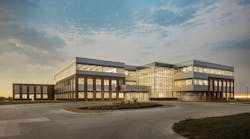Oklahoma's Capitol finally topped out
The Oklahoma Capitol in Oklahoma City was completed in 1917 without the traditional dome that symbolizes a seat of government. Its dome will be finished this year.
The project was completed by Capitol Dome Builders, a design-build venture of Manhattan Construction, Tulsa, and architect/engineer Frankfurt Short Bruza (FSB) of Oklahoma City. FSB did the architectural design and engineering for the $21 million project.
Due to funding problems, a raised dome was not originally constructed. An 80-ft.-diameter circular roof opening at the center of the building was instead covered with a flat "saucer dome." Portions of the original dome, including its stained-glass skylight, plaster crown and cut limestone, have been saved as historic artifacts. Nevertheless, the original construction allocated $15,000 to construct columns capable of supporting a future raised dome.
The designers' aim was to be sympathetic to the historic nature of the Capitol and true to the intent of the original design proposed for dome, interpreted in today's materials, according to Fred Schmidt, FSB's director of architecture.
The new feature consists of an outer dome constructed of precast concrete and cast stone, and an inner coffered dome. The top of the inner dome has a 20-ft.-diameter oculus. Above the oculus is a backlighted stained-glass representation of the state seal.
Re-creating old features
Since the artisans who built the building have passed on, contemporary techniques were used to replicate the appearance of the original work. For example, factory-produced glass-reinforced gypsum panels were used to create egg-and-dart design features of the inner portions of the dome.
Preliminary work included a feasibility study to determine if the Capitol could support the steel-framed dome's weight of 5 million pounds. Sample borings were taken from footings, columns and ring beams to make sure that concrete had adequate strength. Evaluation of the building's expected seismic performance took into account not only the existing structure, but also the new loads that would be imposed by the dome.
A 22-ft.-tall bronze statue of a Native American warrior was hoisted to the top of the 155-ft.-high dome in June in conjunction with the annual Red Earth Native American gathering. The massive statue was sculpted by artist and state Sen. Enoch Kelly Haney.
The Capitol was designed by architect Layton, Wemyss and Smith, Oklahoma City. Stewart Construction Co. began work on the building, which was constructed for $1.5 million, in 1914. It was built on a "pay-as-you-go" basis and cost less than 17 cents per sq. ft.
A grassroots effort to complete the dome was begun in 1988. Largely through an effort spearheaded by Gov. Frank Keating, 75% of construction costs for the dome project was raised through private donations.
A popular misconception is that Oklahoma's had been the only state capitol not topped by a dome. Actually, more than 10 state capitols are currently without a dome, but Oklahoma's had been the only one originally designed with a dome that didn't have one.
The completed Capitol dome will be officially dedicated on Nov. 16, Oklahoma Statehood Day.

